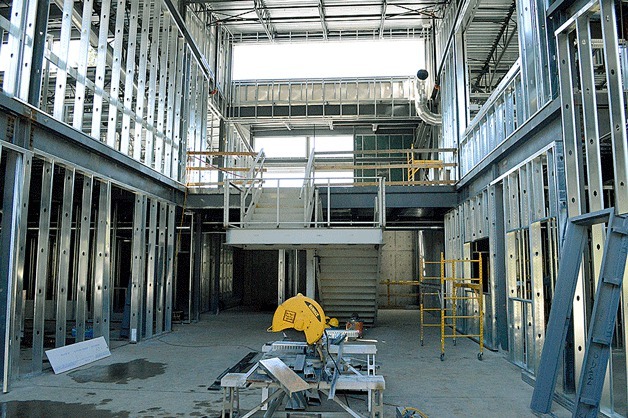If you’re one of the thousand people who have taken a class at Bainbridge Artisan Resource Network, you understand the magic.
You’ve carved bookbinding tools out of elk bone, woven on a four-harness table loom, learned to knot pearls. Maybe you signed up for Electro-Etching, built a smoker during open studio hours or rubbed elbows with the wood whisperer.
If not, you’re part of that other demographic — the unaware, over-occupied or apprehensive.
Bet you $10 the separation won’t last. (Conveniently, that’s the cost of BARN’s drop-in fee, so it’s a win-win.)
The artisan network’s 25,000-square-foot, ADA-accessible campus, due to be complete next January and operational by late spring, will be hard to resist.
From the circular drive at Three Tree Lane, you step inside a light-soaked main lobby, huge east-facing windows parading alders, firs and willows. Below, due to the property’s slope, sits the Commons, a grand two-story “third place” for members to interact across disciplines, admire posted work or simply break from the buzz of creating.
In the interest of being kind to North Town Woods neighbors, BARN’s quieter studios are clustered to the north. Louder studios for jewelry artists and metal machining reside to the south, closer to the fire station.
Tapped to construct all the building’s cabinets, the woodworkers’ studio, comprised of both bench room and wood shop, will be finished first. An exterior dust collector will suck up residue from the latter, which will house saw stops, a sliding table saw, a 36-inch-wide sanding machine, 24-inch-wide surfacer, a band saw and eight lathes. On top of the machinery, there will be room for 30 to 40 makers.
Moving clockwise around the first floor, glass arts comes next. Besides the main workspace, with its own on-grade entrance, there will be a wet room, with hose outlets and floor drains, and a kiln room, with a minimum of four kilns and a cooling unit to make the heat tolerable for long stretches.
Bainbridge Community Broadcasting, BARN’s newest collaborator, will produce podcasts from an acoustically-isolated space next door.
Eventually, BARN executive director Mark Nichols hopes to add how-to videos to the studio’s repertoire. He’ll have a green screen in his office for recording interviews.
Moving north, past the kitchenette and two bathrooms, the home of looms and sewing machines — the Fiber Arts studio — emerges. Second in size only to the woodworking studio, Fiber Arts will have a dye garden and a separate dye room, with a 12-foot sink and a washer and dryer.
Printmakers won’t need their spectacles, thanks to two skylights, which will shine light on the studio’s letterpresses, which come in “papa bear, mama bear and baby bear sizes,” says board president Sallie Maron, and a new Takach printing press, the biggest table-top press on the market. They’ll share the space with their book arts buddies, who are particularly passionate about pop-ups and paper.
The last relevant space on the first floor map, besides the aforementioned Commons and its adjacent kitchenette, is a classroom. Most studios are designed — by Johnpaul Jones, no less — to host classes in-room, but the classroom functions as an additional resource should space get tight.
Upstairs, we go. Beginning on the neighborly side of the second floor, you’ll first encounter the writers. They’ll have a smallish room, stocked with bookshelves, a whiteboard, soft furnishings and several carrels.
Just north is an administrative space for kitchen arts, then its crowning glory: the commercial kitchen. An accordion partition will separate the kitchen from an adjacent meeting space that will also be available to the community for rent.
If you could fly between walls, you’d be in the electronic arts room next, which Nichols calls the hacker space because of its two 3-D printers, which were built from scratch.
Metal arts is composed of welding and the metal machining shop. The former will have its own hoist arm to grab large materials from outside. Also, steel insets in the floor for helpful banging.
Last is fine metals/jewelry. There will be a main space, filled with workstations, plus a soundproof hammering room, which Nichols — can you tell he has a sense of humor yet? — says is for the elves.
None of these studios are set in stone, Maron is quick to interject.
“The building is designed to be flexible,” she said.
The steel walls are easy to move and reassemble, should the community’s preferences and needs change down the road.
Which is good for Nichols, who is already plotting an addition to the lineup, though it won’t require reassembly.
The last destination is his office and the administrative wing.
“Office arts!” he proclaims.
But he’s not really joking. He’d like to teach classes on leadership and nonprofit management and grow the organization’s internship program.
The room to the south, which was originally laid out as a meeting space, will have two intern workstations, cubicles for a bookkeeper and other staff, plus a marketing workstation and projector.
Paying for all this wonderment is another matter.
Details for fundraising are less concrete, with $1.5 million still to go — but Maron is holding out.
“We think as people begin to see what it is, they’ll want to become supporters,” she said.
For the first time ever, BARN is part of One Call for All’s Red Envelope campaign, which began again this month, and the organization’s board is offering a Hard Hat Tour on Sunday, Oct. 23 for potential donors. Readers can email info@bainbridgebarn.org to sign up.
Membership fees, currently $300 per year for individuals and $450 for family, will probably go up, Maron said, but not by much.
“We want everybody to be a part of BARN, so it won’t be a dramatic change; it will be accessible,” she said.
Drop-in passes will continue to be offered along with scholarships.
Jessica Shelton is a reporter for the Bainbridge Island Review and can be reached at jshelton@bainbridgereview.com.



